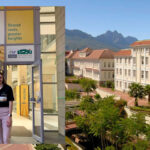
Stellenbosch University Helping African Countries to Protect their Banana Industries against Fusarium Wilt TR4
In June, two staff members of the Department of Plant Pathology assisted the Food and Agricultural Organisation (FAO) of the United Nations to prepare countries in Southern and Eastern Africa for a possible incursion of a devastating fungus that causes a lethal disease in bananas. Prof Altus Viljoen and Dr Diane Mostert have been doing research on Fusarium wilt in bananas for more than 15 years and have trained and supported national plant protection organisations (NPPOs), scientists and growers in Africa and globally. They participated in two workshops, one in Johannesburg and the other in Nairobi, Kenya, to help NPPOs from 16 countries in the Southern African Development Community (SADC) and eight Eastern African countries to develop contingency plans should the disease enter their countries.
Bananas serve as an important staple food for many Africans. The crop is an essential source of income and employment and is a nutritious staple food for more than 400 million people. In Africa, bananas to the value of $4.3 billion are grown by more than 20 million resource-poor farmers. However, bananas on the continent may be threatened by a highly virulent strain of the Fusarium wilt fungus, called Foc TR4, that was first detected in northern Mozambique in 2013. At the time, the fungus was identified by the research group of Prof Viljoen and Dr Mostert, who have since presented numerous training events and workshops on the diagnosis and management of the pathogen in Africa, Asia and Latin America. In February of this year, Prof Viljoen visited Ecuador to advise government researchers on methods for mutating bananas for Foc TR4 resistance, while Dr Mostert visited Lebanon in May to evaluate the status of the disease in the country and to propose means to reduce the impact of the fungus on bananas.
Foc TR4 is difficult to manage. The fungus is soilborne and cannot be eradicated from infested soil. It survives as durable spores for decades, affecting all susceptible bananas planted in such fields. Foc TR4 is also difficult to detect when it is introduced into banana farms and may spread locally and regionally before it is contained. It is thus necessary to prepare African countries for a possible incursion of the fungus by strengthening national capacities, raising awareness and introducing preventative measures.
 Figure 1. Delegates at an FAO workshop in Johannesburg on strengthening the capacity of plant protection officials in Southern Africa to respond to plant health emergencies. Figure 2. Plant health officials representing eight Eastern African countries met in Nairobi, Kenya, to discuss strategies to prevent Foc TR4 from entering their countries.
Figure 1. Delegates at an FAO workshop in Johannesburg on strengthening the capacity of plant protection officials in Southern Africa to respond to plant health emergencies. Figure 2. Plant health officials representing eight Eastern African countries met in Nairobi, Kenya, to discuss strategies to prevent Foc TR4 from entering their countries.
Fusarium wilt TR4 was detected in Mayotte, two islands in the Comoros archipelago, in 2019, and in the Grand Comoros earlier this year. The latter detection is the direct result of a training workshop for African scientists held by Dr Mostert and other international scientists in November 2022. Apart from Mozambique and the Mayotte islands, Fusarium wilt TR4 has not yet been reported from other Southern and Eastern African countries.
The Foc TR4 workshops in Johannesburg and Nairobi were organised by the FAO with the support of the African Union’s Inter-African Phytosanitary Council (AU-IAPSC). These activities were part of the implementation of the global project, OSRO/GLO/208/USA, financed by the United States Agency for International Development’s Bureau of Humanitarian Assistance (USAID BHA). The project aims to build alliances between all relevant stakeholders to strengthen the plant health emergency management capacities of FAO member countries.



